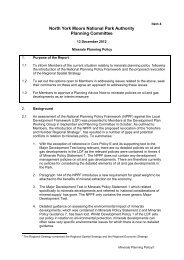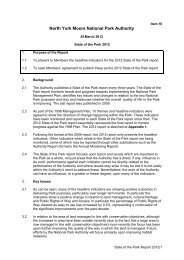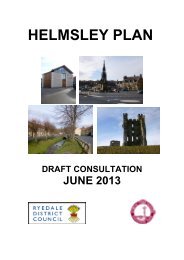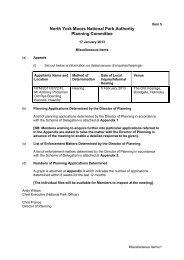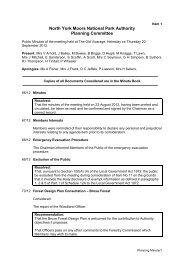EnvironmentHow <strong>Management</strong> <strong>Plan</strong> progress will be reportedINDICATORArea of moorland managed in line withconservation objectivesTARGET / DESIRED DIRECTION OF CHANGEArea has been maintained or increased2.9 Trees and WoodlandsWoodland covers 22% of the <strong>National</strong> <strong>Park</strong> and provides avaluable economic and environmental resource to the area.About 20% of woodlands in the <strong>National</strong> <strong>Park</strong> are ‘ancient’,having been continuously wooded for at least 400 years,although half of this is plantation on ancient woodland sites(PAWS), having been replanted mainly with conifers. Woodlandis a major component of the <strong>National</strong> <strong>Park</strong>’s landscape and hasan increasingly recognised role in storing carbon and reducingthe risk of soil erosion and subsequent sedimentation of rivers.<strong>Plan</strong>tation woodlands are generally concentrated in the largeForestry Commission and private forests in the south-east andon the fringes of the <strong>National</strong> <strong>Park</strong> to the south-west, westand north. These forests were mainly planted as a strategictimber resource in the 20th century and design was not alwayssympathetic to landscape appearance due to the angular natureof some of them. They are now increasing in diversity andage structure and opportunities are being taken to improvelandscape as felling programmes proceed. Careful planningand control of operations has given rise to exciting majorimprovements in recent decades through development ofremnant native woodland and heathland networks, protectionof riparian and wetland areas, more sensitive drainage andsoftening of forest edges.The plantation forests are now generally considered to bebeneficial to the biodiversity of the <strong>National</strong> <strong>Park</strong> due toincreased structural diversity and increasing opportunitiesfor more sensitive management as the forests have matured.Major gains for biodiversity have been secured through theremoval of plantation woodland at May Moss, Bumble Woodand Southwoods for example. In addition the larger plantation50 www.northyorkmoors.org.uk
forests support nationally important populations of nightjar, aswell as being the main stronghold for some scarce species suchas goshawk, crossbill and pine marten. However, in some forests,particularly on the poorer soils and the more exposed uplandsites, the species currently preferred for timber production canhave an impact on biodiversity and amenity value. New anddeveloping knowledge about species choice, tree provenanceand silvicultural systems must continue to be applied if plantationforests are to contribute positively to biodiversity and landscape,and continue to be an economic resource.Smaller plantations and farm woodland can have a significantimpact on landscape quality and careful consideration ofmanagement and new planting is required. Many plantationsin inappropriate locations have been removed over the past10 years and this has had a very positive landscape impact.There are sites where removal of plantations and restorationto moorland will be a priority on conservation grounds andin any event timber production may no longer be consideredeconomic on inaccessible or demanding ones. Some sites maybecome less economically viable as higher yielding speciesbecome less successful due to climate change. Restoration toopen habitats may be an option to consider but this will need tobe balanced against a range of objectives, including the desire toincrease carbon sequestration. The government’s policy in thisarea requires that compensatory planting should be undertakenelsewhere when woodland is to be converted to open habitat.Ancient semi-natural woodlands, which make up 2% of the<strong>National</strong> <strong>Park</strong>, are more fragmented and have survived onsteeper ground in the valleys and dales with many beingisolated and unmanaged. Although most ancient native woodsare relatively small there are some exceptions, with significantlarger woods at Mulgrave and Roxby in the northern part of the<strong>National</strong> <strong>Park</strong> and Forge Valley in the south east. It is possiblethat an increase in demand for wood fuel could see a resumptionof management in many of these native woodlands and thiscould help improve their condition if done in accordance withthe UK Forestry Standard.PAWS, where conifers have replaced the native trees, are a largeand important element of the biodiversity of the <strong>Park</strong>. The <strong>North</strong><strong>York</strong> <strong>Moors</strong> contain the largest concentration of PAWS in thenorth of England. Despite significant restoration schemes by theForestry Commission and some private owners, assisted by the<strong>National</strong> <strong>Park</strong> Authority, the remaining resource is being steadilyeroded and much is in danger of permanently losing its valueas an ancient woodland site as, over time, the surviving ancientnative woodland ground flora and shrub layer will disappear. It istherefore important that PAWS are not replanted with successivegenerations of conifers as this would lead to the permanentloss of an important habitat. Such events should, therefore,only happen in specific circumstances or/and with suitablemitigation. Once restored, PAWS must be maintained to preventconifer re-growth. Restoring PAWS to native species provides amajor opportunity to enhance woodland habitats and increaseresilience, as well as potentially reducing soil erosion, neutralisingpH levels and contributing to improving habitat networks.The <strong>Park</strong> has nationally important populations of veteran treesand has some of the best sites in northern England for old treesand their associated wildlife. Areas such as Bilsdale and Farndalestill support quite extensive areas of old wood pasture, andsmaller numbers of ancient trees are present in various placesthroughout the <strong>National</strong> <strong>Park</strong>. The trees are often centuriesold and it may be necessary to manage them or to maintain afavourable environment around them to help them survive inthe long term. Establishing a new generation of young treesin notable veteran tree areas can be important and there aresignificant opportunities to plant trees to improve habitatconnectivity and to enhance landscape.Some of the <strong>National</strong> <strong>Park</strong>’s woodland is protected atinternational level as Special Areas of Conservation and 1,400hectares is designated as Sites of Special Scientific Interest.Priority woodland habitats are identified in the Local BiodiversityAction <strong>Plan</strong> and actions will be informed by a review of the2002 forest habitat network report 33 , commonly known as thePeterken Report.Trees and woodlands have a valuable role in storing carbon inwood and forest soils. It is estimated that 7.5 million tonnes ofcarbon is stored in the Forestry Commission owned woodland.They also play an important role in mitigating the effects ofclimate change through intercepting rain water which potentiallyreduces the severity of flooding downstream and also lessensthe effects of sedimentation of rivers. Trees also provide shadewhich may become increasingly important for wildlife in riversand on livestock farms if summers become hotter. The role oftrees outside woods, such as infield and field boundary trees, inproviding habitat connectivity and benefitting livestock farmingin response to climate change is starting to be more widelyaccepted.33 Native Woodland Development in the <strong>North</strong> <strong>York</strong> <strong>Moors</strong>and Howardian Hills (George F Peterken, 2002)<strong>North</strong> <strong>York</strong> <strong>Moors</strong> <strong>National</strong> <strong>Park</strong> <strong>Management</strong> <strong>Plan</strong>51




